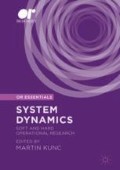Abstract
This paper is the first of its type in that it provides an empirical study comparing the two simulation approaches of discrete-event simulation (DES) and system dynamics (SD). Prior comparison work is limited and mostly based on the authors’ personal opinions. In the present work, the comparison is based on managers’ (executive MBA students) perceptions of two simulation models of the same problem, one in DES and one in SD. The study found that there is no significant difference from the users’ point of view between DES and SD in terms of model understanding and model usefulness. Some minor differences were found in terms of complexity and validity of the models, and the model results. The implications of our findings regarding model understanding, model complexity, model validity, model usefulness and model results are discussed.
Access this chapter
Tax calculation will be finalised at checkout
Purchases are for personal use only
Preview
Unable to display preview. Download preview PDF.
References
Akkermans HA (1995). Modelling with managers. Participative business modelling for effective strategic decision-making. PhD thesis, Technische Universiteit Eindhoven.
Bard JF (1978). The use of simulation in criminal justice policy evaluation. J Crim Justice 6(2): 99–116.
Brailsford S and Hilton N (2001). A comparison of discrete event simulation and system dynamics for modelling healthcare systems. In: J Riley (ed). Proceedings of ORAHS 2000, Glasgow, Scotland, pp. 18–39.
Buckingham A and Saunders P (2004). The Survey Methods Workbook: From Design to Analysis. Cambridge; Malden, MA: Polity.
Cox GB, Harrison P and Dightman CR (1978). Computer simulation of adult sentencing proposals. Eval Program Plann 1(4): 297–308.
Coyle RG (1985). Representing discrete events in system dynamics models: A theoretical application to modelling coal production. J Opl Res Soc 36(4): 307–318.
Fisher NI (1983). Graphical methods in nonparametric statistics: A review and annotated bibliography Int Stat Rev 51: 25–58.
Forrester JW (1961). Industrial Dynamics. Cambridge, MA: MIT Press.
Grove P, MacLeod J and Godfrey D (1998). Forecasting the prison population. OR Insight 11(1): 3–9.
Korporaal R, Ridder A, Kloprogge P and Dekker R (2000). An analytic model for capacity planning of prisons in the Netherlands. J Opl Res Soc 51(11): 1228–1237.
Kwak NK, Kuzdrall PJ and Schniederjans MJ (1984). Felony case scheduling policies and continuances—a simulation study. Socioecon Plann Sci 18(1): 37–43.
Lane DC (2000). You just don’t understand me: Models of failure and success in the discourse between system dynamics and discrete event simulation. Working paper, 00.34:26.
Law AM (2007). Simulation Modeling and Analysis. 4th ed. Boston and London: McGraw-Hill.
Mak H-Y (1993). System dynamics and discrete event simulation modelling. PhD thesis, London School of Economics and Political Science.
Morecroft JDW and Robinson S (2005). Explaining puzzling dynamics: comparing the use of system dynamics and discrete- event simulation. In: JD Sterman, MP Repenning, RS Langer, JI Rowe, JM Yarni (eds). Proceedings of the 23rd International Conference of the System Dynamics Society. Boston, MA: System Dynamics Society.
Morecroft JDW and Sterman J (eds) (1994). Modeling for Learning Organizations. System Dynamics Series. Portland, OR: Productivity Press.
Pidd M (2004). Computer Simulation in Management Science. Chichester: Wiley.
Randers J (1980). Elements of the System Dynamics Method. Cambridge, MA; London: MIT Press.
Robinson S (2001). Soft with a hard centre: Discrete-event simulation in facilitation. J Opl Res Soc 52(8): 905.
Robinson S (2002). Modes of simulation practice: approaches to business and military simulation. Sim Mod Practice and Theory 10(8): 513–523.
Robinson S (2004). Simulation: The Practice of Model Development and Use. Chichester: Wiley.
Robinson S (2008). Conceptual modeling for simulation Part 1: Definition and requirements. J Opl Res Soc, online publication 24 January 2007, doi:https:// doi.org/10.1057/palgrave.jors.2602368.
Robinson S, Meadows M, Mingers J, O’Brien FA, Shale EA and Stray S (2003). Teaching OR/MS to MBAs at Warwick Business School: A turnaround story. Interfaces 33(2): 67–76.
Siegel S (1957). Nonparametric statistics. Am Stat 13(3): 13–19.
Sterman J (2000). Business Dynamics: Systems Thinking and Modeling for a Complex World. Boston; London: Irwin/McGraw-Hill.
Sweetser A (1999). A Comparison of System Dynamics and Discrete Event Simulation. In: RY Cavana, JAM Vennix, EAJA Rouwette, M Stevenson-Wright and J Candlish (eds). Proceedings of 17th International Conference of the System Dynamics Society and 5th Australian & New Zealand Systems Conference. Wellington, New Zealand: System Dynamics Society.
Vennix JAM (1996). Group Model Building: Facilitating Team Learning Using System Dynamics. Chichester: John Wiley.
Wilk MB and Gnanadesikan R (1968). Probability plotting methods for the analysis of data. Biometrika 55(1): 1–17.
Author information
Authors and Affiliations
Editor information
Editors and Affiliations
Copyright information
© 2018 The Author(s)
About this chapter
Cite this chapter
Tako, A.A., Robinson, S. (2018). Comparing Discrete-Event Simulation and System Dynamics: Users’ Perceptions. In: Kunc, M. (eds) System Dynamics. OR Essentials. Palgrave Macmillan, London. https://doi.org/10.1057/978-1-349-95257-1_9
Download citation
DOI: https://doi.org/10.1057/978-1-349-95257-1_9
Published:
Publisher Name: Palgrave Macmillan, London
Print ISBN: 978-1-349-95256-4
Online ISBN: 978-1-349-95257-1
eBook Packages: Business and ManagementBusiness and Management (R0)

